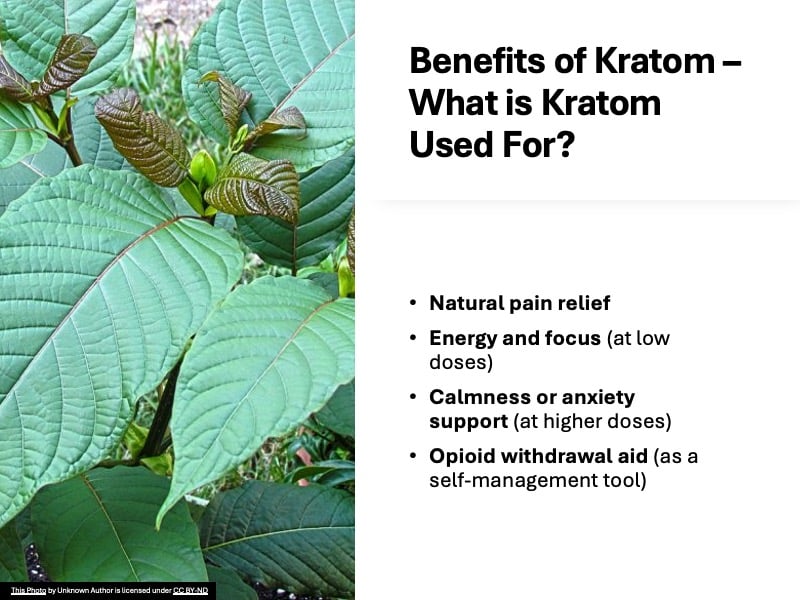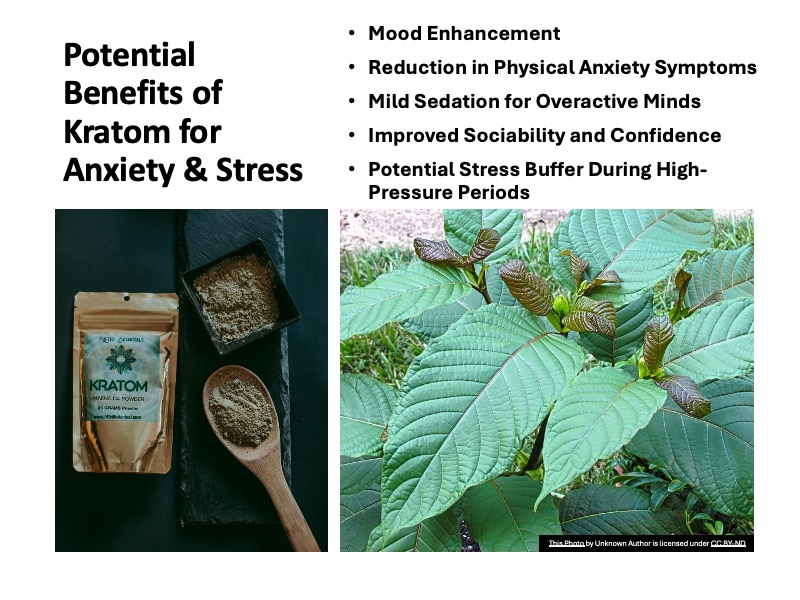Kratom: What it Is, Benefits, Safety Concerns, Uses & More
Kratom (Mitragyna speciosa) is a tropical evergreen tree indigenous to Southeast Asia, where it has been traditionally used for centuries as a natural remedy for fatigue, pain, and opiate withdrawal.
Its leaves contain active alkaloids, primarily mitragynine and 7-hydroxymitragynine, that interact with the body’s opioid receptors and other neurochemical systems, producing stimulant effects at low doses and sedative, analgesic effects at higher doses.
In recent years, kratom has drawn global attention for its potential to manage pain, improve mood, and support emotional resilience.
In the United States alone, an estimated 1.7 million people aged 12 and older used kratom in 2021, according to data from the Substance Abuse and Mental Health Services Administration (SAMHSA).
However, due to its potential for addiction, withdrawal symptoms, and liver toxicity, kratom should be approached with extreme caution, if at all, and avoided by those with underlying health conditions or a history of substance dependence.
Despite its herbal origin and deep cultural roots in countries like Thailand, Malaysia, and Indonesia, kratom remains legally and medically controversial, particularly in the United States, due to concerns about its safety profile, risk for dependence, and regulatory ambiguity.
This guide explores what kratom does, how it affects the brain and body, how long its effects last, and what informed users should understand before using kratom responsibly and legally.
What Is Kratom?
Kratom (Mitragyna speciosa) is a tropical tree in the coffee family native to Southeast Asia, where it has been used for centuries as a traditional herbal remedy for pain relief, increased energy, and treatment of opioid withdrawal.
The leaves of the plant contain active alkaloids, primarily mitragynine and 7-hydroxymitragynine, which interact with the body’s opioid and adrenergic receptors, producing both stimulant effects at lower doses and sedative, analgesic effects at higher doses.
While kratom has a long-standing cultural and medicinal role in countries like Thailand, Malaysia, and Indonesia, its rise in popularity across Western countries has been far more recent and controversial.
Globally, usage continues to grow, and the U.S. kratom market is now valued at over $1 billion annually, driven largely by sales through online retailers and specialty shops.
Despite its growing popularity, kratom is not legally recognized as a drug, dietary supplement, or food additive in the United States.
The U.S. Food and Drug Administration (FDA) has not approved any products containing kratom or its primary alkaloids for medical use.
The FDA has also concluded that kratom is a “new dietary ingredient” for which there is insufficient evidence to ensure safety, and has warned that products containing kratom may be considered adulterated under the Federal Food, Drug, and Cosmetic Act.
- As a result, kratom exists in a legal gray area.
- While it is not federally scheduled, it is banned or restricted in several U.S. states and municipalities.
- The FDA continues to monitor its safety and has issued seizures of kratom-containing products when marketed with unsubstantiated medical claims.
Given these complexities, it’s important for consumers to be fully informed about kratom’s potential benefits, risks, and legal status before use, especially when purchasing it online or using it to self-manage conditions like pain, anxiety, or opioid withdrawal.
Potential Benefits of Kratom: What is Kratom Used For?

Kratom is most commonly used for its potential to relieve pain, boost energy, and support mood balance.
While it is not FDA-approved for any medical condition, it is sold in the U.S. as a supplement, often in powder, capsule, or tea form.
Among its many applications, kratom for anxiety has gained particular interest due to its calming effects at lower doses, which some users report helps ease nervous tension and promote relaxation without heavy sedation (Swogger & Walsh, 2017).

Common uses of kratom include:
- Natural pain relief
- Energy and focus (at low doses)
- Calmness or anxiety support (at higher doses)
- Opioid withdrawal aid (as a self-management tool)
What Does Kratom Do?
Kratom’s effects vary depending on the strain and dose:
- Low doses (1–5g): Stimulating, energizing, improved sociability and focus.
- Moderate doses (5–8g): Balanced mood effects, slight sedation, reduced anxiety.
- High doses (>8g): Sedative, possibly euphoric, with pain-relieving properties.
These effects occur because kratom’s alkaloids bind to mu-opioid receptors, similar to opioids but with a different pharmacological profile.
How Does Kratom Make You Feel?
People describe the kratom experience in several ways:
- Calm, relaxed, and centered (especially red vein strains)
- More talkative or focused (especially white or green vein strains)
- Mild euphoria or enhanced well-being
- For some, nausea or dizziness, especially at higher doses
Kratom can produce euphoric sensations at higher doses, but it does not make you “high.”
The “high” is generally milder than that of opioids or other controlled substances.
Users often compare the effect to a mix between caffeine and a weak painkiller.
Is Kratom Good for Weight Loss?
There is no strong scientific evidence that kratom directly promotes weight loss, but some users report losing weight while taking it.
These anecdotal reports may be due to several indirect effects of kratom use rather than any fat-burning or metabolic-enhancing properties.
Possible Reasons for Weight Loss with Kratom:
- Appetite Suppression: Kratom may reduce appetite in some individuals, leading to lower overall calorie intake.
- Increased Energy: Low doses of stimulating kratom strains (like white or green vein) can enhance motivation and physical activity, which could increase calorie expenditure.
- Mood and Focus Improvement: Some users feel more focused or emotionally stable with kratom, which might improve adherence to exercise or dietary routines.
However, these effects are highly individualized, and any weight loss may come with unintended consequences, such as:
- Nutrient deficiencies due to poor eating habits
- Dependence if kratom is used frequently to manage appetite or mood
- Digestive issues that interfere with nutrient absorption
Given the lack of clinical research and the potential risks involved, kratom should not be considered a safe or reliable method for weight loss.
If you’re aiming to lose weight naturally, strategies like exercise, dietary changes, and stress management offer safer, more sustainable results.
Is Kratom Legal?
Kratom is federally legal in the U.S., but banned in several states and cities, including:
- Alabama
- Arkansas
- Indiana
- Vermont
- Rhode Island
- Wisconsin
- Some counties in California and Florida
Always check local laws before purchasing or using kratom.
Is Kratom an Opioid?
Technically, kratom is not an opioid, but its alkaloids interact with opioid receptors in the brain.
This is why kratom has both potential for pain relief and addiction, especially when used frequently or in large amounts.
How Long Does Kratom Last?
The effects of kratom can vary widely depending on the dose, strain, and individual metabolism.
In general, kratom’s effects begin within 15 to 45 minutes after consumption and can last anywhere from 2 to 6 hours.
Understanding how long kratom lasts is essential for safe and effective use, especially when managing symptoms like pain, anxiety, or fatigue.
- Onset: 15–45 minutes after consumption
- Peak effects: 1.5 to 2.5 hours
- Duration: 4–6 hours, depending on dose and strain
- Lingering effects: Up to 8 hours in some users
How Long Does Kratom Stay in Your System?
Kratom’s half-life is estimated to be 24 hours, which means it may remain in your body for several days:
- Urine: Up to 5–7 days for heavy users
- Blood: About 1–3 days
- Saliva and hair: Not commonly tested but may show presence for longer durations
Does Kratom Show Up on a Drug Test?
Kratom does not appear on most standard drug tests, such as the commonly used 5-panel or 10-panel screenings, which typically test for substances like THC, cocaine, opiates, amphetamines, and PCP.
However, specialized or expanded drug tests can detect kratom’s active alkaloids, mitragynine and 7-hydroxymitragynine, if those compounds are specifically targeted.
Some federal agencies, employers, or legal authorities may use these advanced panels in situations involving suspected substance abuse, workplace incidents, or court-ordered screenings.
While rare, false positives have been reported due to structural similarities with opioids, but these are typically resolved through confirmatory testing.
Does Kratom Show Up as an Opiate?
Kratom is not classified as an opiate, and it does not usually test positive for opiates on a standard drug panel.
However, on expanded or highly sensitive drug tests, particularly ones designed to detect synthetic or atypical opioids, kratom could trigger a false positive in rare cases due to its opioid receptor activity.
For accuracy, any unexpected result on a drug test involving kratom use should be followed up with GC-MS (Gas Chromatography-Mass Spectrometry) confirmatory testing, which can differentiate kratom alkaloids from traditional opioids.
Is Kratom Safe?
While kratom has a long history of traditional use, its safety profile is still being studied. The most common side effects include:
- Nausea, dry mouth, dizziness
- Constipation or digestive upset
- Dependence or withdrawal symptoms with long-term use
The risk of harm increases when kratom is taken at high doses, mixed with other drugs, or used frequently without medical supervision.
According to a 2024 review in Frontiers in Pharmacology, kratom has a diverse pharmacological profile, and while it’s not as dangerous as opioids, risks still exist—particularly with unregulated products (Henningfield et al., 2024).
Is Kratom Addictive?
Yes, kratom can be addictive, especially when used in high doses or daily. Withdrawal symptoms may include:
- Irritability
- Muscle aches
- Insomnia
- Depression or anxiety
Dependency risk appears lower than opioids but higher than caffeine.
Does Kratom Cause Liver Damage?
There are isolated case reports of liver toxicity linked to kratom use, especially with high doses or adulterated products (LiverTox, 2020).
Symptoms may include:
- Dark urine
- Itching or jaundice
- Fatigue
While rare, these issues highlight the importance of using kratom from reputable sources and in moderation.
Does Kratom Lower Testosterone?
There is limited but growing scientific evidence examining how kratom affects testosterone and hormonal health.
A 2018 cross-sectional study published in the Journal of Ethnopharmacology evaluated hormone levels in 19 long-term kratom users in Malaysia, all of whom consumed kratom tea or juice daily for over two years (Singh et al., 2018).
Researchers measured serum testosterone, follicle-stimulating hormone (FSH), and luteinizing hormone (LH) to assess any hormonal disruptions.
The results showed no significant differences in testosterone or gonadotropin levels among these long-term users.
Additionally, no impairments were found in hematological or biochemical parameters, suggesting that regular kratom use at moderate daily doses (76–94 mg mitragynine) was not associated with hormonal suppression in this sample.
While anecdotal reports occasionally link kratom with reduced libido or other hormonal imbalances, this peer-reviewed study provides some of the first human data indicating that kratom does not necessarily lower testosterone, at least within the context of traditional use.
However, more large-scale, controlled human studies are still needed to confirm these findings and evaluate dose-dependent or strain-specific effects.
What is Maeng da Kratom?
Maeng Da kratom is one of the most well-known and widely marketed kratom strains, often promoted for its potency, longer-lasting effects, and balanced profile of stimulation and pain relief.
The name “Maeng Da” loosely translates to “pimp grade” in Thai slang, originally used to signal higher quality or enhanced strength.
Key Facts
- Origin: While kratom naturally grows in Thailand, Indonesia, and Malaysia, most Maeng Da kratom today comes from Indonesia, particularly from regions with rich, volcanic soil.
- Hybridization: Maeng Da is not a natural strain but is believed to be a selectively bred or grafted hybriddesigned to maximize the effects of the kratom leaf’s alkaloids—especially mitragynine, the compound responsible for its stimulating and mood-enhancing properties.
- Strain Types: It’s available in red vein, green vein, and white vein varieties. Each has slightly different effects:
- Red Maeng Da: More calming and analgesic; often used for pain or stress relief.
- Green Maeng Da: Balanced energy and mood boost with some pain relief.
- White Maeng Da: More stimulating and energizing; used to increase focus and motivation.
Maeng Da is often chosen for:
- Chronic pain relief
- Mental focus and productivity
- Mood enhancement or mild euphoria
- Combating fatigue
Because of its higher alkaloid concentration, Maeng Da kratom may work at lower doses than other strains, but this also raises concerns about tolerance, dependence, and side effects when overused.
What Is Kratom Tea?
Kratom tea is made by steeping dried or powdered kratom leaves in hot water. This method is popular for:
- Smoother digestion
- Milder onset
- More controlled dosing
However, boiling kratom too long can degrade some of its alkaloids.
Pros and Cons of Kratom
Kratom is a controversial herbal supplement with both passionate supporters and vocal critics.
While some people report benefits like pain relief and improved mood, others experience side effects and health concerns.
Understanding the potential pros and cons of kratom can help you make a more informed and responsible decision.
Pros of Kratom
While kratom has been used for centuries in traditional Southeast Asian medicine, the benefits reported by modern users are mostly anecdotal and not well-supported by large-scale clinical trials.
That said, many people turn to kratom for its perceived ability to relieve pain, reduce stress, and boost energy, often as a natural alternative to pharmaceuticals.
The following are some of the most commonly reported benefits of kratom.
- Natural Pain Relief: Kratom’s alkaloids, especially mitragynine and 7-hydroxymitragynine, interact with opioid receptors to reduce discomfort without traditional narcotics.
- Mood Enhancement: Many users report improved mood, reduced anxiety, and a sense of emotional well-being, especially with green and white vein strains.
- Increased Energy and Focus (at Low Doses): In small amounts, kratom can act as a mild stimulant, improving concentration and sociability without the jitters of caffeine.
- Traditional and Cultural Use: Kratom has a long history of use in Southeast Asia for labor endurance, pain relief, and social interaction, adding to its perceived safety by some users.
- Opioid Withdrawal Support (Anecdotal): Some individuals use kratom to taper off opioids, citing its ability to ease withdrawal symptoms—though this should only be done under medical supervision.
Cons of Kratom
Despite its plant-based origin and growing popularity, kratom carries a range of potential risks that users should be aware of.
Most safety concerns stem from case studies, limited toxicology data, and self-reported experiences rather than rigorous scientific evidence.
Below are the most frequently discussed drawbacks associated with kratom use, especially in the context of long-term or high-dose consumption.
- Addiction and Dependence Risk: Regular use, especially at high doses, can lead to physical dependence, with withdrawal symptoms similar to opioids: irritability, muscle aches, insomnia, and depression.
- Liver Toxicity Concerns: Case reports suggest kratom may cause liver damage in some users, especially when combined with other substances or used in unregulated forms.
- Limited Research and Regulation: Most available studies are observational or based on self-reports, and kratom is not FDA-approved for any medical condition.
- Variable Potency and Product Quality: Kratom sold online or in stores can vary dramatically in strength and purity, increasing the risk of contamination or accidental overdose.
- Legal Uncertainty: While kratom is federally legal in the U.S., it is banned in several states and municipalities. Its status remains under review by the FDA and DEA.
Final Thoughts: Should You Try Kratom?

Kratom is a complex, plant-derived substance with a wide range of reported effects—ranging from stimulating and mood-lifting at low doses to calming and pain-relieving at higher doses.
While some individuals claim it helps with chronic pain management, anxiety, or fatigue, the scientific evidence is still limited, and its safety profile remains uncertain.
Personally, I’ve never used kratom, and I most likely never will.
As a professional athlete and health educator, I’m cautious about substances that pose potential risks for liver damage, dependence, and withdrawal.
The lack of consistent regulation, research-backed dosage guidelines, and long-term safety data makes kratom a questionable option in my view.
Disclaimer: Always consult with a qualified healthcare provider before starting any new supplement, medication, or herbal product, including kratom, to ensure it’s safe and appropriate for your individual health needs.
If you’re searching for a non-opioid solution to chronic pain or stress, I recommend exploring CBD and full-spectrum hemp products instead.
I’ve used CBD regularly for years to support recovery and reduce inflammation, and it’s become a trusted part of my personal wellness routine.
That said, if you are considering kratom, speak with a qualified healthcare professional to ensure it aligns with your personal health needs and doesn’t interact with other medications or conditions.
Always research your local laws, buy only from reputable vendors, and approach use with caution and awareness.
As more studies emerge, we’ll hopefully gain clearer guidance on whether kratom can be used safelym or if its risks outweigh the potential rewards.



